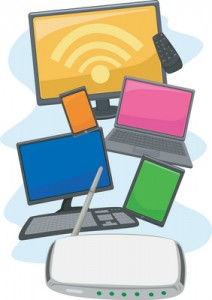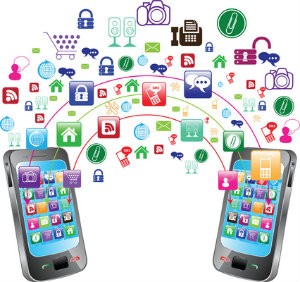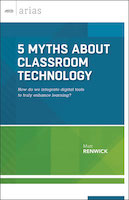BYOD in the Classroom: Necessary or Nice?

I received a survey from a technology distribution company. “If you answer these five questions, we will suggest the optimal technology for your classroom’s needs,” stated the email message. Curious, I took the quiz.
Here were the topics for the questions: Processing speed, device storage, device weight, cost per unit, and how the technology will be used. Of all the questions, only the last one had any relation to teaching and learning.
We need better questions
BYOD stands for “Bring Your Own Device.” This means each student brings their personal technology into their learning space. This includes smart phones, tablets, eReaders, and laptops. The concept suggests that by allowing students to use their own devices for learning, they will be more engaged in instruction and find school more relevant. Plus, the district saves money because they do not have to purchase equipment.

We should consider the needs of the students, the essential understandings of the curriculum, and the mission and vision of the school and district. How much access is required for students, what the purpose for the devices would be in classrooms, and what type of audience would be involved with student learning are three important considerations. Technical details, such as operating systems and applications, might also be looked at, but they should not be the determining factors. Nice, but not necessary.
Here are a few questions to consider when deciding if BYOD is necessary in your middle grades classroom:
► Does the technology accommodate and differentiate for all learners’ needs?
► Are students provided both voice and choice with technology, thereby increasing ownership and engagement?
► Are there opportunities for students to engage in peer feedback and collaborative work?
Keep these questions in mind as you read the following description of how one secondary school English teacher applied BYOD into her conceptual unit on isolation in literature.
BYOD in Action
Melanie Kozlowski, an English teacher at Lincoln High School in Wisconsin Rapids, WI, created a nine square menu sheet of different online resources to read, listen to, and watch. Students could choose which book excerpts and multimedia to explore that related to their learning.
She emailed this menu of learning options to her students as a Google Doc. Within each resource square were three ways to access the content: a QR (quick reader) code to the online source, a hyperlinked title of the resource that the students could click on, and a shortened URL (uniform resource locator) if the students wanted to type in the address on a desktop computer. Melanie also allowed her students to print off this menu and linked resources at school.
She gave the students a date in the near future when they were going to discuss the content they were exploring in small groups and as a whole class. These seniors were expected to take notes during their studies to answer the essential question, “How would a person seeking isolation find the experience both beneficial and risky?”
Students in Melanie’s classroom worked at their own pace and provided responses in a personally-preferable format. Students were given clear expectations about their use of their own smartphones, tablets, or laptops within the nine square sheet: “Remember, I expect your usage of digital devices to be related to our tasks and learning targets.”

These students also listened to the soundtrack by Eddie Vedder from the movie about the book and read the musician’s lyrics to make connections. Others brought up an excerpt of Walden by Henry David Thoreau to read on their iPads. What would Thoreau think about this isolation paradox?
Melanie also included more recent additions to the literature canon on survival. In one of the squares, she linked an audio interview with Cheryl Strayed, author of Wild. As students captured their thinking within another Google Doc, they shared their work with Melanie and classmates by giving them access in the settings. They could provide feedback for each other from home using the Comments feature, continuing the conversation they had at school.
Necessary or Nice?
Just as Melanie asked her students to focus on the essential question for her unit of study, let me ask you to go back to the three questions I posed earlier to determine if BYOD was a necessary strategy in her classroom.
► Does the technology accommodate and differentiate for all learners’ needs? Melanie curated multiple media formats for students. Their devices served as a conduit for Cheryl Strayed’s interview, Eddie Vedder’s lyrics, and the digitized excerpt of Walden.

► Are there opportunities for students to engage in peer feedback and collaborative work? Yes. Having students put their notes in a Google Doc gave everyone the opportunity to view others’ work and increase their collective understanding through connected collaboration.
Melanie’s own reflections reveal the reasoning that led her to believe BYOD in the secondary classroom can be necessary:
“I save having to make a lot of paper copies for students. There is also the benefit of not having to provide mobile technology for every student. They can use what they already have, be it a smart phone, tablet, or laptop. Another benefit is how engaged they get in this differentiated unit. It even engaged the seniors who would otherwise check out at the end of a semester.”
Conclusion
Having students bring their own devices to school is not a panacea for all the challenges in the secondary classroom. Yet if it is planned with thoughtfulness and intention, we have seen BYOD increase student engagement and relevance while reducing costs for the school. The best part: Teachers and students can be creative and autonomous in how this looks in classrooms.
How might BYOD look in your middle grades classroom or school? How do you meet challenges when students don’t have access to devices? What projects have you tried, if any?
______

Portions of this article were adapted from 5 Myths About Technology: How do we integrate digital tools to truly enhance learning? All rights reserved.
































I would retitle your piece Necessary, nice or damaging. While the example you give is a good example of using tech, there are so many more that actually inhibit learning. Many times our use of screens do not allow students to construct their learning. We equate clicking with learning.
Larry Cuban’s blog has run my own piece on this (https://larrycuban.wordpress.com/2015/11/25/physics-teacher-speaks-out-on-technology-alice-flarend/) as well as those by other teachers (https://larrycuban.wordpress.com/ ).
Hi Alice, regardless of the potential disruptions and unintentional misuse of technology with poor outcomes, new teaching styles won’t just be invented — they’ll be expected. As you’ve mentioned, ‘Google can provide factual information on almost any topic, but without design, those facts remain a pile of useless lumber’. I couldn’t agree more, but BYOD can be used to bolster educational outcomes if it’s done well.
If you have a few minutes please take a look at this post and see some of the discussion going on in Australia.
If teachers have the right tools to bring their BYOD lessons to life, it will also help their students explore, discover, and problem-solve their way to better learning outcomes from any device. If students are engaged in what they’re doing, it will also provide better opportunities for support, mentoring and meaningful conversations in the classroom.
I am a huge fan of both mobile devices and Google docs. I have found that students are engaged when they have choices and that collaborative work in a digital space helps students write better, problem solve effectively, and get to know their classmates on a social level. The key element here is not the technology, but the teacher. Tech is a tool, and it’s one our students use better than we do, so we need to catch up!